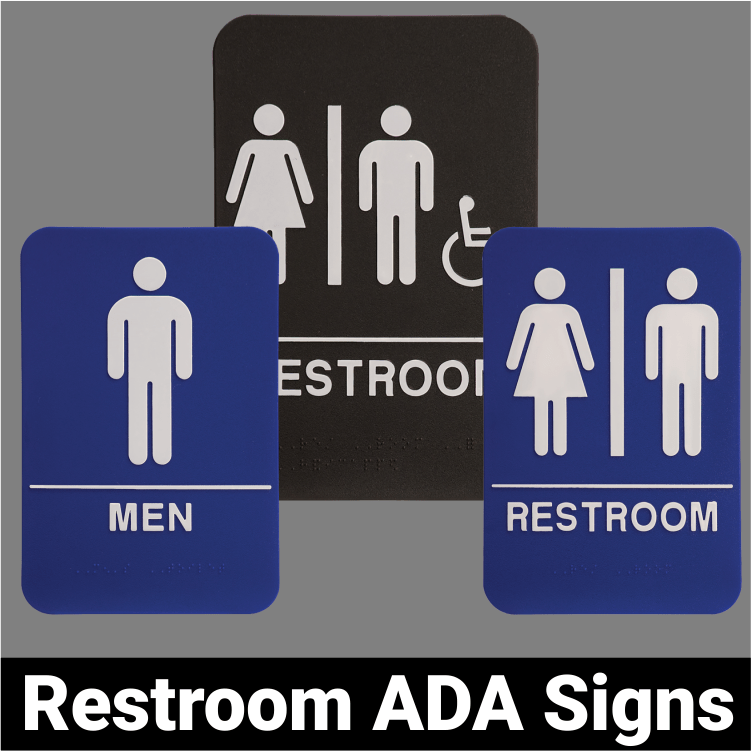The Effect of ADA Signs on Community Availability
Discovering the Secret Functions of ADA Indications for Improved Ease Of Access
In the realm of access, ADA indications offer as silent yet effective allies, ensuring that areas are comprehensive and accessible for individuals with specials needs. By integrating Braille and tactile components, these signs break obstacles for the aesthetically impaired, while high-contrast color systems and legible font styles provide to varied visual requirements.
Importance of ADA Compliance
Making sure compliance with the Americans with Disabilities Act (ADA) is critical for fostering inclusivity and equal accessibility in public spaces and workplaces. The ADA, established in 1990, mandates that all public centers, employers, and transportation solutions suit individuals with handicaps, ensuring they delight in the exact same civil liberties and chances as others. Conformity with ADA criteria not just fulfills lawful responsibilities but additionally improves a company's credibility by demonstrating its commitment to diversity and inclusivity.
Among the vital facets of ADA conformity is the implementation of available signs. ADA indicators are designed to guarantee that individuals with impairments can quickly navigate with areas and buildings. These indications should abide by particular guidelines concerning size, font, shade comparison, and positioning to ensure exposure and readability for all. Correctly executed ADA signage helps remove obstacles that people with impairments typically come across, therefore advertising their self-reliance and confidence (ADA Signs).
Moreover, sticking to ADA guidelines can mitigate the threat of possible fines and lawful consequences. Organizations that fail to follow ADA guidelines might deal with penalties or legal actions, which can be both economically burdensome and harmful to their public photo. Thus, ADA conformity is essential to cultivating an equitable atmosphere for everyone.
Braille and Tactile Aspects
The unification of Braille and tactile components into ADA signage personifies the concepts of access and inclusivity. It is normally put below the corresponding message on signs to make sure that individuals can access the details without visual aid.
Responsive aspects expand beyond Braille and include raised icons and personalities. These parts are created to be noticeable by touch, enabling individuals to identify area numbers, toilets, leaves, and various other essential locations. The ADA establishes particular guidelines regarding the dimension, spacing, and positioning of these tactile aspects to optimize readability and ensure consistency across various settings.

High-Contrast Color Design
High-contrast color pattern play an essential role in boosting the exposure and readability of ADA signage for people with visual problems. These plans are necessary as they make best use of the distinction in light reflectance between message and background, ensuring that indicators are quickly noticeable, even from a range. The Americans with Disabilities Act (ADA) mandates using details shade contrasts to accommodate those with minimal vision, making it a vital aspect of conformity.
The efficacy of high-contrast colors exists in their ability to attract attention in various lights conditions, including poorly lit environments and locations with glow. Generally, dark message on a light background or light message on a dark background is utilized to attain optimal contrast. As an example, black text on a white or yellow background provides a plain aesthetic difference that helps in fast recognition and understanding.

Legible Fonts and Text Size
When taking into consideration the layout of ADA signage, the option of clear font styles and ideal text size can not be overemphasized. These components are crucial for guaranteeing that indicators come to individuals with aesthetic disabilities. The Americans with Disabilities Act (ADA) mandates that fonts must be sans-serif and not italic, oblique, manuscript, extremely ornamental, or of unusual form. These requirements assist guarantee that the text is easily readable from a range which the characters are appreciable to diverse audiences.
According to ADA standards, the minimum text elevation should be 5/8 inch, and it needs to boost proportionally with checking out distance. Consistency in message size adds to a cohesive aesthetic experience, helping individuals in original site browsing environments successfully.
Moreover, spacing in between lines and letters is essential to readability. Sufficient spacing prevents characters from showing up crowded, boosting readability. By sticking to these criteria, developers can considerably boost availability, ensuring that signs offers its intended objective for all people, no matter their aesthetic capabilities.
Efficient Positioning Techniques
Strategic positioning of ADA signs is crucial for taking full advantage of ease of access and making sure conformity with lawful criteria. ADA standards specify that indications ought to be mounted at a height in between 48 to 60 inches from the ground to guarantee they are within the line of view for both standing and seated individuals.
Furthermore, signs have to be put surrounding to the latch side of doors to allow simple identification prior to entry. Uniformity in link indication positioning throughout a facility boosts predictability, minimizing confusion and enhancing overall individual experience.

Conclusion
ADA indicators play a vital function in advertising accessibility by integrating attributes that address the requirements of people with handicaps. Incorporating Braille and tactile aspects makes certain crucial info comes to the visually impaired, while high-contrast color pattern and clear sans-serif font styles boost visibility across different illumination problems. Effective placement techniques, such as proper placing elevations and critical locations, further help with navigation. These aspects collectively promote a comprehensive atmosphere, highlighting the value of ADA conformity in making certain equivalent gain access to for all.
In the world of availability, ADA indications serve as silent yet effective allies, making certain that areas are navigable and inclusive for people with specials needs. The ADA, passed in 1990, mandates that all public facilities, companies, and transport services accommodate people with impairments, ensuring they appreciate the exact same rights and opportunities as others. ADA Signs. ADA indicators are made to ensure that people with impairments can easily browse through structures and areas. ADA guidelines state that signs need to be installed at a height between 48 to 60 inches from the ground to guarantee they are within the line of sight for both standing and seated individuals.ADA indications play a vital website link duty in promoting access by integrating attributes that deal with the demands of individuals with handicaps